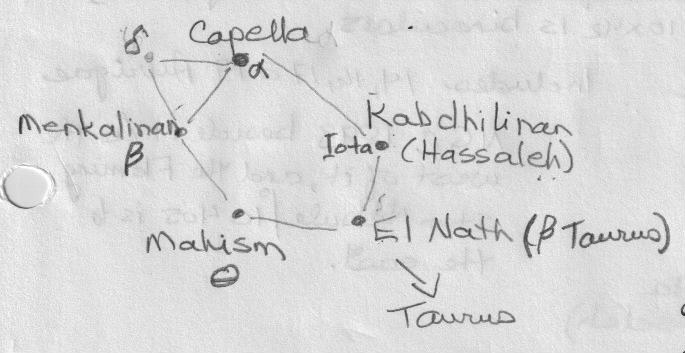Constellation: Auriga, Canis Major, Cassiopeia, Gemini, Leo, Orion, Ursa Major, Ursa Minor
Asterisms: Kemble's Cascade, Sickle Asterism in Leo, Winter Circle
Stars: Aldebaran, α & β Orionus, Polaris
Messier Object: M42 (Orion Nebula), M43, M45 (Pleaides)
Star Cluster: Hyades (Melotte 25, Collinder 50, Caldwell 41)
NGC: NGC 1981
Conjunction: Moon-Mars-Venus (Explore the Moon (Binocular) - January 31, 2017)
Location: Home / St. Croix Observatory (SCO)
Date: 2017-01-31
Time: 7:00 PM - 7:30 PM / 8:00 PM - 11:00 PM
Temperature: -7° C to -6° C
Instrument: Visual + Binoculars 10x30 IS
Magnification: x10
Transparency: Very Good
Seeing: Very Good
An incredibly clear night. Clearer than we have seen in quite a while. Didn't look for M36, M37 or M38 in Auriga. Found an interesting fact online later this evening: this is the site of the anti-Galactic Centre (opposite centre of the Milky Way).
|
Leo - Sickle Asterism The exciting moment for me this evening was the discovery of Leo over the rooftop of our home. I wondered what the semi-circle of stars were part of anything or whether it was wishful thinking on my part. Come to find out through SkySafariPro that what I was seeing was the sickle. The others stars of the constellation (including Denebola) were hidden by the house. When I attempted to find the constellation on another side of the house, the street lights obscured my view. However, I did clearly see the 5-star sickle asterism that ended in Regulus (α Leo). |
 |
|
M45 (Pleaides) |
Ursa Major / Ursa Minor Time: 8:10 PM Location: SCO Instrument: Visual + Binoculars 10x30 IS S&T Chat ref: 31, 32, 33, 43, F The little bit of cloud quickly dissipated; Big Dipper and Polaris easily found. Surprised that I could finally see all the stars in the Little Dipper! |
|
Orion Binoculars |
|
 |
Auriga Time: 8:45 PM Location: SCO Instrument: Visual S&T Chat ref: 12 Capella was easy to find in the Winter Circle. The other 5 stars of the constellation were easily visible with naked eye. This constellation wasn't difficult to find regardless of where in the sky they were located. |
Canis Major Time: 8:52 PM Location: SCO Instrument: Visual S&T Chat ref: 7 Didn't look for M41. Sirius was easily detected. From Sirius, I found Mirzam and Adhara. Wizen and Aludra took some time to find naked eye but were eventually found. Didn't find the other stars of the constellation (marked as an 'x' in the sketch). |
 |
| Cassiopeia + Kemble's Cascade Time: 9:00 PM Location: SCO Instrument: Visual S&T Chat ref: 1, 3, 72 Easily identified all 5 stars visually. used it to locate Kemble's Cascade. Didn't sketch them. |
Hyades (Melotte 25, Collinder 50, Caldwell 41) |
| Winter Circle Time: 10:12 PM Location: SCO Instrument: Visual At 8:15 PM, a little cloud cover in the SE soon dissipated to once again reveal Orion and Canis Major. Came back out at 10:15 PM to clear skies and -7° C. The winter circle was so clearly identifiable this beautiful clear night. I was so excited about seeing the circle that, other than Orion and Leo, I didn't locate stars in the other constellations that were so high in the sky. Missed opportunity initially. After observing the Moon-Venus-Mars conjunction, I identified stars in 6 constellations: Orion, Gemini, Auriga, Canis Major, Taurus and Canis Minor. NOTE: Canis Minor couldn't be made out despite Procyon being very visible. |
|



